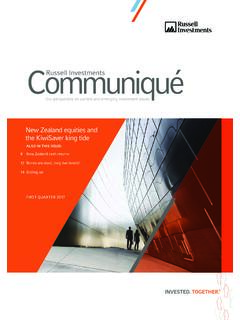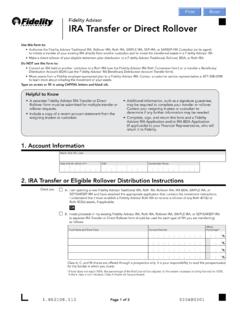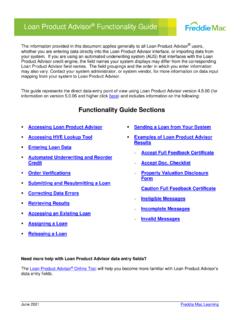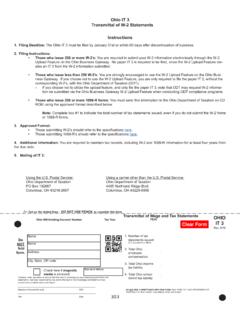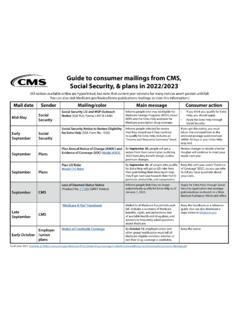Transcription of 2021 Value of an Advisor Study - Russell Investments
1 Value . 2021 Value of an Advisor Study A sharper focus on the Value of your advice. THIS MATERIAL IS FOR FINANCIAL PROFESSIONAL USE only . AND NOT FOR DISTRIBUTION TO CURRENT OR POTENTIAL INVESTORS. Executive summary Russell Investments has always focused on the Value of advisors. And never was an Advisor 's Value so obvious as during 2020. It was a year that tested both investors and advisors in so many ways. Financial markets fell sharply early in the year when the global spread of the COVID-19 virus forced a sudden shuttering of economic activity, only to recover strongly in the final months on positive vaccine news. Through it all, many of us found ourselves reassessing our lifestyles and our way of doing business.
2 Many of us may have found our priorities and outlooks have changed as those of your clients may have. That's why we think it is the perfect time for you to place a sharper focus on the full Value of your advice and ensure you are communicating that Value to your clients. Our simple and handy formula can help you show your clients the overall Value you bring to them. To better reflect the changing role of a financial Advisor , we've reassessed the formula we use in our annual report. After all, it's likely that you're not just a broker anymore. Given the holistic wealth management advice you may provide to investors and their loved ones, your role is now more likened to a family wealth Advisor .
3 Our new formula takes a closer look at that broadened role. It more closely reflects the tangible benefits for clients such as receiving a customized client experience, or ensuring the products held in their portfolio align with their goals, circumstances, and preferences. Given the volatility seen in 2020, it's no surprise that the biggest contributor to Advisor Value is your role as a behavioral coach. In fact, this category on its own more than offsets the 1% fee advisors typically charge for their services. Let's take a look at the full Value equation of an Advisor 's services. It's as easy as ABC and clearly shows that the estimated Value is much greater than the typical advisory fee.
4 In 2021, we believe the Value of an Advisor in the is The ABCs of Advisor Value The Value of an Advisor Study is meant to quantify the contribution that the technical and emotional guidance a trusted human Advisor can offer. The formula we created is designed to categorize the areas of Value creation in a repeatable, memorable way: A Active rebalancing of investment portfolios +. B Behavioral coaching +. C Customized client experience & planning > Your fee We believe is greater the annual advisory fee you + than charge clients P Product alignment +. T Tax-smart planning & investing 2 / FINANCIAL PROFESSIONAL USE only 2021 Value of an Advisor Study / Russell Investments A B C P T.
5 A is for Active rebalancing of investment portfolios = When markets are rising calmly, it can be easy to underestimate the importance of regular rebalancing. But in a volatile year such as 2020, active rebalancing of a portfolio could have played a significant role in smoothing out investment performance. For instance, with most economic sectors shuttered and a widespread shift to a virtual work environment, we saw a few key technology companies dominate returns over the year and substantially increase their weighting in the S&P 500 Index. Without regular rebalancing, a client's portfolio could have become overly heavy in large capitalization equities. Over longer periods of time, this sort of shift can meaningfully change the risk and return potential of a portfolio.
6 For example, if an investor had purchased a hypothetical balanced portfolio of 60% equities and 40% fixed income in January 2009 and it had not been actively rebalanced since then, by the end of 2020, the risk profile of the portfolio would look very different. That original balanced portfolio would have become a growth portfolio, with 80% invested in equities and only 20% in fixed income. That would expose the investor to risk they didn't agree to and could be a concern if equity markets suddenly reversed, as we saw in early 2020. When balanced becomes the new growth The potential result of an un-rebalanced portfolio January 1, 2009 December 31, 2020. FIXED. INCOME FIXED EQUITIES.
7 EQUITIES INCOME. 20%. 15%. 20%. 40% 40%. REAL 36%. 4%. 15% ASSETS 4%. 5%. 55%. 5%. 11%. 5% 15% 7% 17% 76%. 5%. 5%. REAL ASSETS Large Cap Growth Emerging Markets Equity Large Cap Value Global Real Estate Small Cap Value Fixed Income Int'l Developed Equities Total Equity Large Cap Growth Large Cap Value Fixed Income The drift was most Allocation Allocation Allocation Allocation pronounced: 38% 140% 13% -50%. Source: Hypothetical analysis provided in the chart & table above is for illustrative purposes only . Not intended to represent any actual investment. Source for both chart & table: Large Cap Growth: Russell 1000 Growth Index, Large Cap Value : Russell 1000 Value Index, Small Cap: Russell 2000 Index, International Developed Equities: MSCI World ex USA Index, Emerging Markets Equity: MSCI Emerging Markets Index; Global Real Estate: FTSE EPRA NAREIT Developed Index, and Fixed Income: Bloomberg Barclays Aggregate Bond Index.
8 Russell Investments / 2021 Value of an Advisor Study FINANCIAL PROFESSIONAL USE only / 3. A B C P T. Additionally, rebalancing can result in higher returns and lower Additional returns. Actively responding to changes in the markets has the potential to add approximately in additional returns. Volatility reduction. Actively rebalancing may also reduce portfolio volatility by an estimated amount of Hypothetical rebalancing comparison of $500,0002. March 2005 December 2020. BUY AND HOLD ACTIVE REBALANCING. = Annualized return Standard deviation Ending Value $ million $ million Potential reduction in portfolio volatility Standard deviation is a statistical measure of the degree to which an individual Value in a probability distribution tends to vary from the mean of the distribution.
9 The greater the degree of dispersion, the greater the risk. 1. Source Portfolio: Diversified portfolio consists of 30% large cap, 5% small cap, 15% developed, 5% emerging markets, 5%. REITs, and 40% fixed income. Returns are based on the following indices: large cap = Russell 1000 Index; small cap = Russell 2000. Index; developed = MSCI EAFE Index; emerging markets = MSCI Emerging Markets Index; REITs = FTSE EPRA/NAREIT Developed Index; and fixed income = Bloomberg Barclays Aggregate Bond Index. Start date corresponds to index start dates (January 1988 is the inception of the MSCI Emerging Markets Index). The example compares the risk and return profiles of this portfolio if it was never rebalanced during that time period versus if it was actively rebalanced once annually.
10 2. For illustrative purposes only . Not meant to represent any actual investment. Those numbers may sound small. But over the years, even small increases in returns can add up. More importantly, the reduction in risk can help smooth out returns which could help keep your clients invested during periods of market volatility. Take a sharper look at communicating the Value of Your resource hub*: your advice Do you share with your clients a written statement on: The potential benefits of a systematic rebalancing policy What your strategic rebalancing policy is Six Good Reasons Bull vs. Bear How frequently the portfolios are rebalanced to Stay Invested Market Your approach to strategic rebalancing during (Brochure, client-ready) (1-pager, client-ready).

